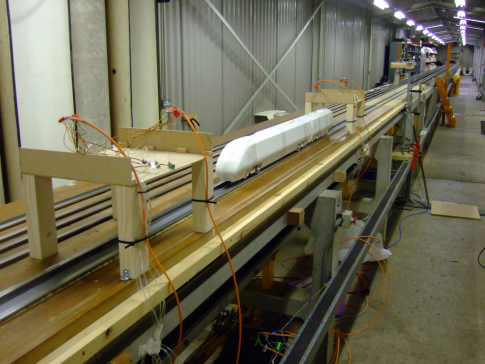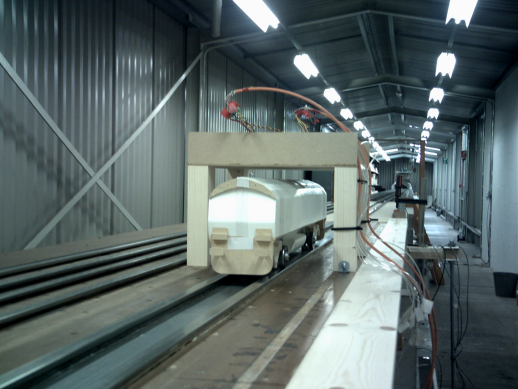Moving Model Rig - applications
click here for non-railway applications

The TRAIN rig is one method of carrying out aerodynamic investigations on trains. Its specific advantages are:
- It avoids the uncontrolled ambient conditions and expense associated with full scale tests, and model test geometry can be varied relatively quickly and cheaply
- Unlike conventional wind tunnels and CFD, it can be used to investigate transient phenomena, such as train passing, slipstreams etc.
- It can be used to calibrate/validate computational models of train tunnel pressure transients
- The use of full scale train speeds ensure Mach number similarity when undertaking tests of pressure wave phenomena in tunnels
Typical examples of studies that can be performed include:
- investigations into the effects of cross-winds on train stability
- slipstream studies (at the trackside and on station platforms with and without cross-winds)
- trains passing
- effect of train shape (development of the aerodynamic design of new trains and improvement of existing trains
- determination of train empirical factors for unsteady flow predictions in tunnels
- exploration of methods for the alleviation of transient pressures in tunnels
- investigation of primary wave steepening in tunnels and the development and alleviation of micro-pressure waves
Click here or go to YouTube to see a video of the rig in action!

The rig has been used in the past for a range of different types of test:
- Tunnel pressure transients for a variety of types of train
- Aerodynamic design of train noses
- Pressure pulses around trains in the open air
- Ventilation flows in cross passages
- Train slipstream behaviour
- Determination of pressure loss coefficients and friction factors for trains
Some of this work is described in the following papers
Further publications will be added as they become available from the work currently being undertaken in the rig. This includes work on pressures in semi-confined structures, slipstreams around high-speed trains and pressures on vehicles in cross-winds.
Other applications
The TRAIN Rig can potentially be used for a wide range of vehicle testing, but is particularly useful where the motion of a body in the vicinity of the ground is being studied. Possible applications include:
- Investigation of road vehicle behaviour in cross winds
- Measurement of road vehicle aerodynamics in confined situations
- Measurements of road vehicle aerodynamics during overtaking and vehicle passing
- Measurement of pollutant dispersion around moving road vehicles in rural and urban geometries
- Investigations of aircraft and wing behaviour in close proximity to a ground plane
- Investigation of the aerodynamics of bluff bodies in proximity and intermittent contact with the ground (sports balls, wind borne debris)
Please contact us to discuss any ideas you may have for using the rig.